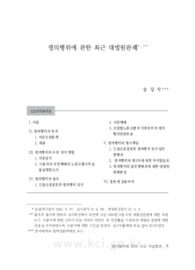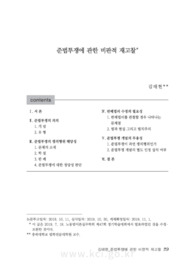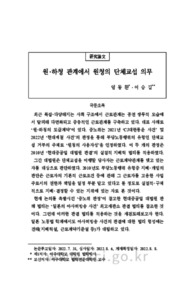

-
미리보기
서지정보
· 발행기관 : 노동법이론실무학회
· 수록지 정보 : 노동법포럼 / 6호 / 5 ~ 39페이지
· 저자명 : 송강직
초록
In this paper, I analyzed strike and the law which has been established by Supreme Court of Korea since 2009. In addition, I compared traditional case law of strike with one after 2009.I focused on some critical problems concerning the legitimate elements of strike such as strike objects of reduction of surplus labor, strike means and procedures on the「 Trade Union and Labor Relations Adjustment Act」(hereinafter referred to as TULRAA) and related criminal liability, etc.
When compared to the traditional case law, it should be noted that the Supreme Court issued many different and new holdings in resent strike cases. These can be summarized as follows:
① Is a sit down strike in a lobby lawful in case of using the same oor of the same building with the third party? Traditionally, the Court has held that a sit down strike is lawful only when it is partial and nonexclusive within it's employer's premise. However, in a recent case, the Court held that the sit down strike constituted a criminal liability of invasion into a construction in relations with the third party. According to this holding, employees using the same oor with the third party do not virtually strike against it's employer.
② In general, the Court has held that the employees, even under lock out, are able to use facilities for union activity, dormitory, etc. However, in a recent case, the Supreme Court held that an employer can restrict his or her employees' access to their workplace during lock out, where facilities for union activity including dormitory are located in the same or adjacent place to the production facilities. The Supreme Court. of course, still hold that not only the employer has to offer his or her employees another replacement of facilities for union activity to restrict their access to the facilities but also there should be a reasonable cause to do it. It seems that there are no substantial changes in the Supreme Court's stance. In this regard, it can be said that the latter holding of the Supreme Court embodies a general principle regarding the employer's obligation in restriction on his or her employees' access to the facilities for union activity as well as the employees' right to use the facilities even under lock out.
③ When the Minister of Labor makes a decision to conduct emergency adjustment, a strike shall not be resumed until thirty days have passed from the date of publication of the decision in Korea(TULAAA, Sec. 76(1) and Sec. 77). According to the provisions, employees must stop the strike when the decision of the emergency adjustment is issued. Under this system, although an employer does not permit the employees to participate in protesting demonstration against the decision by national center union, some of them conducting the strike can participate in the protest meeting. The Supreme Court held that this kind of participation in protesting demonstration did not violate the prohibitions against strike after the publication of the decision. This case is worthy of note in that it is the rst case concerning stopping of a strike when the decision of emergency adjustment is issued.
Under the Supreme Court's decision, a strike will be unlawful when a strike does not satisfy all requirements for legitimacy such as objects, means and procedural rules of strike in the TULAAA, In this case, the union officers usually receive criminal punishment in Korea. Even though the Supreme Court holds that all unlawful strikes should not be punished with criminal liability, I think the Supreme Court is firmly keeping this position now. Therefore, I would like to point out that a strike's legality, in principle, shall be judged only on it's objects and means. In my opinion, the procedural rules under the TULAAA have no direct relations to the employer and judgement of whether the strike is lawful or not. Furthermore, when workers stop offering their work force simply, the strike should not be regarded as a criminal liability.영어초록
In this paper, I analyzed strike and the law which has been established by Supreme Court of Korea since 2009. In addition, I compared traditional case law of strike with one after 2009.I focused on some critical problems concerning the legitimate elements of strike such as strike objects of reduction of surplus labor, strike means and procedures on the「 Trade Union and Labor Relations Adjustment Act」(hereinafter referred to as TULRAA) and related criminal liability, etc.
When compared to the traditional case law, it should be noted that the Supreme Court issued many different and new holdings in resent strike cases. These can be summarized as follows:
① Is a sit down strike in a lobby lawful in case of using the same oor of the same building with the third party? Traditionally, the Court has held that a sit down strike is lawful only when it is partial and nonexclusive within it's employer's premise. However, in a recent case, the Court held that the sit down strike constituted a criminal liability of invasion into a construction in relations with the third party. According to this holding, employees using the same oor with the third party do not virtually strike against it's employer.
② In general, the Court has held that the employees, even under lock out, are able to use facilities for union activity, dormitory, etc. However, in a recent case, the Supreme Court held that an employer can restrict his or her employees' access to their workplace during lock out, where facilities for union activity including dormitory are located in the same or adjacent place to the production facilities. The Supreme Court. of course, still hold that not only the employer has to offer his or her employees another replacement of facilities for union activity to restrict their access to the facilities but also there should be a reasonable cause to do it. It seems that there are no substantial changes in the Supreme Court's stance. In this regard, it can be said that the latter holding of the Supreme Court embodies a general principle regarding the employer's obligation in restriction on his or her employees' access to the facilities for union activity as well as the employees' right to use the facilities even under lock out.
③ When the Minister of Labor makes a decision to conduct emergency adjustment, a strike shall not be resumed until thirty days have passed from the date of publication of the decision in Korea(TULAAA, Sec. 76(1) and Sec. 77). According to the provisions, employees must stop the strike when the decision of the emergency adjustment is issued. Under this system, although an employer does not permit the employees to participate in protesting demonstration against the decision by national center union, some of them conducting the strike can participate in the protest meeting. The Supreme Court held that this kind of participation in protesting demonstration did not violate the prohibitions against strike after the publication of the decision. This case is worthy of note in that it is the rst case concerning stopping of a strike when the decision of emergency adjustment is issued.
Under the Supreme Court's decision, a strike will be unlawful when a strike does not satisfy all requirements for legitimacy such as objects, means and procedural rules of strike in the TULAAA, In this case, the union officers usually receive criminal punishment in Korea. Even though the Supreme Court holds that all unlawful strikes should not be punished with criminal liability, I think the Supreme Court is firmly keeping this position now. Therefore, I would like to point out that a strike's legality, in principle, shall be judged only on it's objects and means. In my opinion, the procedural rules under the TULAAA have no direct relations to the employer and judgement of whether the strike is lawful or not. Furthermore, when workers stop offering their work force simply, the strike should not be regarded as a criminal liability.참고자료
· 없음태그
-
자주묻는질문의 답변을 확인해 주세요

꼭 알아주세요
-
자료의 정보 및 내용의 진실성에 대하여 해피캠퍼스는 보증하지 않으며, 해당 정보 및 게시물 저작권과 기타 법적 책임은 자료 등록자에게 있습니다.
자료 및 게시물 내용의 불법적 이용, 무단 전재∙배포는 금지되어 있습니다.
저작권침해, 명예훼손 등 분쟁 요소 발견 시 고객센터의 저작권침해 신고센터를 이용해 주시기 바랍니다. -
해피캠퍼스는 구매자와 판매자 모두가 만족하는 서비스가 되도록 노력하고 있으며, 아래의 4가지 자료환불 조건을 꼭 확인해주시기 바랍니다.
파일오류 중복자료 저작권 없음 설명과 실제 내용 불일치 파일의 다운로드가 제대로 되지 않거나 파일형식에 맞는 프로그램으로 정상 작동하지 않는 경우 다른 자료와 70% 이상 내용이 일치하는 경우 (중복임을 확인할 수 있는 근거 필요함) 인터넷의 다른 사이트, 연구기관, 학교, 서적 등의 자료를 도용한 경우 자료의 설명과 실제 자료의 내용이 일치하지 않는 경우
찾으시던 자료가 아닌가요?
지금 보는 자료와 연관되어 있어요!
문서 초안을 생성해주는 EasyAI




